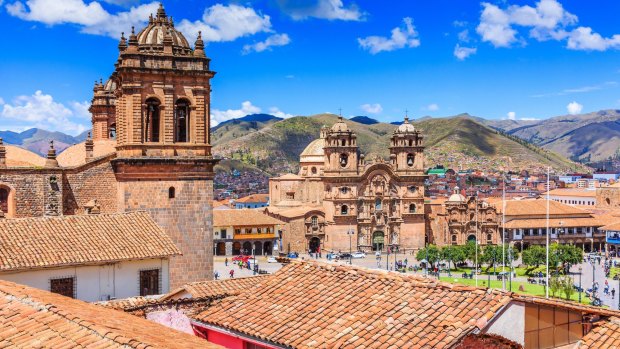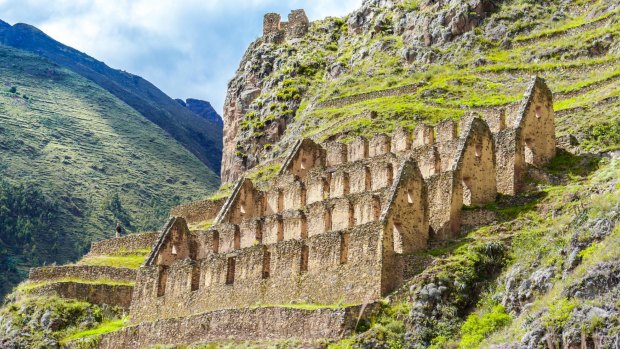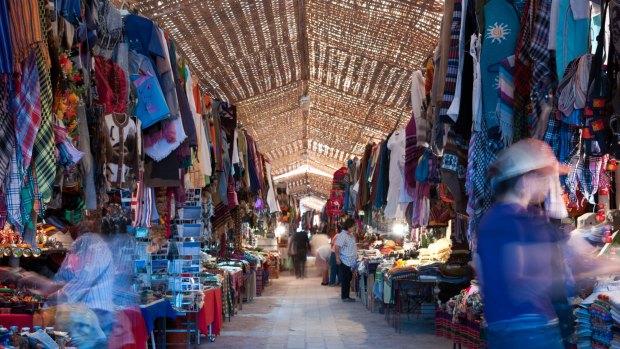This was published 5 years ago
Not just Machu Picchu: 10 things to know about Cusco, Peru
By Mark Daffey

Cusco, the historic capital of the Inca Empire. Credit: Alamy
I WANT TO GO STRAIGHT TO WHERE THE ACTION IS
Cusco's historical showpiece, Plaza de Armas, is a broad, manicured square featuring a monument to the expansionist Incan ruler Pachacuti, who has been described as a South American Alexander the Great. There are restaurants, bars and cafes with elevated vantage points for people watching. The dominant structures facing the square are the 17th century Cusco Cathedral and the Company of Jesus Church both built by the Spanish conquistadors. For information on the history, architecture and artworks contained in each church, a tour is a must. See peru.travel/where-to-go/cusco
I WANT TO SEE THE BEST ART

Peru's Sacred Valley extends along the Urubamba River from Machu Picchu to Pisac.Credit: Alamy
European and Cusquenan artists painted the artworks inside Cusco Cathedral and this diversity is reflected in the varying styles. Statues of Jesus, Mary and Joseph, introduced to Peru by Spanish colonists, are present but also there is a noticeable presence of gold and silver, Incan influences that represent the sun and moon gods. Some dress styles represent elements of Mother Nature. Included is a sizeable painting of the Last Supper with a guinea pig on a serving plate and the traitor Judas mischievously resembling Francisco Pizarro, the Spanish general whose army brought about the downfall of the Inca empire in 1533. See perutraveltips.org/cuzco-cathedral
I FEEL SHORT OF BREATH, WHY?
Upon arriving in Cusco, there's every chance you'll feel breathless, headache-y and perhaps even nauseous. At Cusco's altitude of 3369 metres, that's normal. Less oxygen exists here than at sea level and it takes time to acclimatise to that change. Your best bet is to slow down and drink plenty of fluids but avoid alcohol. Don't try to do too much in your first two or three days. If you can stomach its earthy taste, gritty texture and a perpetually dry mouth, chewing coca leaves will help. And every hotel in town has free coca tea on hand for new arrivals. See healthdirect.gov.au/altitude-sickness

At San Pedro Market, three blocks west of the Plaza de Armas, you can buy everything from cheap panpipes to phallic woodcarvings and Andean shawls.Credit: Alamy
I WANT TO VISIT THE CENTRE OF THE INCAN EMPIRE
The Inca's most important temple, Qorikancha, or Temple of the Sun, was the beating heart from which arterial roads fanned out to the far corners of the empire. Dedicated to Inti, the sun god, its courtyards were filled with gold statues and its walls and floors covered in sheets of gold and silver. All were plundered by the Spanish conquistadors, who built a Christian church on top of the ruins. Subsequent earthquakes damaged the church but its foundations, built out of interlocking blocks of stone by the Incas, still stand – a testament to the Inca's sophisticated masonry skills. See cuscoperu.com/en/travel/cusco/archaeological-centers/qorikancha
I WANT TO GET THE BEST VIEW OF CUSCO?
The Incas built Cusco in the shape of a puma, with the 15th-century fortress of Sacsayhuaman representing the head, the Plaza de Armas the heart, Qorikancha as the hips, and the convergence of the Saphi and Tullumayo rivers said to be the tail. The best overview of the city is from Cristo Blanco, the giant statue of Christ on Pukamuqu Hill, close to Sacsayhuaman, whose six-metre-high drystone walls were fitted with such precision that even a single piece of paper couldn't squeeze between the stones. The hike to the statue, an eight-metre-high version of Rio's Christ the Redeemer, is a 30-minute uphill walk from the Plaza de Armas and is particularly rewarding around sunset, when the lights of Cusco flicker on. See theonlyperuguide.com/peru
I WANT TO EAT AUTHENTIC PERUVIAN FOOD
Peruvian cuisine has become hot news in recent years. Ceviche – raw fish cut into cubes and marinated in lime, chilli and onion – is the premier dish along Peru's coastal regions, while the signature Andean dish is cuy, or guinea pig. Pachapapa, Morena Peruvian Kitchen and Inka Grill serve the tastiest local dishes, including slow-roast guinea pig. The Curry House Korma Sutra's take comes with a subcontinental twist – cuy cooked in a tandoori oven. Cicciolina and Limo fuse Peruvian cooking and ingredients with foreign influences. Several kitchens also offer cooking classes. Cusco Cooking is located close to the Plaza de Armas, while Rooftop Kitchen's top-floor space in the eastern district of Wanchaq affords sweeping views over the city. See cuscocooking.com; rooftopkitchenperu.com
I WANT TO BUY PANPIPES AND ALPACA JUMPERS
At San Pedro Market, three blocks west of the Plaza de Armas, you can buy everything from cheap panpipes to phallic woodcarvings and Andean shawls. Fashion boutiques in the artisanal quarter of San Blas have more upmarket wares in its antique stores, jewellery shops, art galleries and handcrafted musical instrument stores. High-priced, hand-sown alpaca wool jumpers and rugs are sold in Lamaland, Kuna and Alpaca Hand Knitwear Montse Badell. Go to the non-profit Centro de Textiles Traditionales del Cusco for Peruvian ancestral textiles. See textilescusco.org
I WANT TO LEARN ABOUT LOCAL HISTORY AND CUSTOMS
There are museums dedicated to chocolate and textiles in Cusco, and one highlighting the significance of the coca leaf in Peruvian society. Before heading to the archaeological sites of Machu Picchu and the Sacred Valley, consider a visit to the Inca Museum. Housed in a Spanish admiral's colonial home, 24 exhibition rooms are filled with information dating from pre-Inca societies through to the Spanish conquest. The museum's mummified bodies are a highlight. See cuscoperu.com
I WANT TO VISIT MACHU PICCHU
Cusco is the gateway to Machu Picchu, the World Heritage-listed Inca citadel that evaded discovery until American explorer Hiram Bingham stumbled upon it in 1911. Machu Picchu is just 75 kilometres from Cusco, with the Sacred Valley train easily the most atmospheric means of getting there. The train terminates at Aguas Calientes and from there buses ferry visitors up the mountain. Entry tickets must be purchased in advance through the official government website or through travel agencies, with admission now separated into morning and afternoon timeslots. As many as 5600 tickets are issued a day. Visitors must also be accompanied by an official guide, which you can hire outside the entrance gates. Accessing the ruins independently via the Inca Trail is nigh on impossible these days due to the hiking route's popularity. Permits get snapped up soon after release so your only option to do the trail is through a local travel agency or by booking a tour through an operator such as World Expeditions. See machupicchu.gob.pe/inicio
WHAT ELSE SHOULD I SEE IN THE SACRED VALLEY?
Peru's Sacred Valley extends west to east along the Urubamba River from Machu Picchu to Pisac, 1000 metres lower than Cusco. Many locals here still speak Quechua, the language of the Incas, and for many their way of life hasn't changed much; they grow corn, raise alpacas and weave brightly coloured textiles as their forebears did. The textiles centre of Chinchero is a popular first stopover out of Cusco. The agricultural terraces that were carved into the hillsides above Ollantaytambo and Pisac make striking backdrops, and Pisac has a lively produce and handicraft market each Sunday. Moray, west of the village of Maras, was the Incas' agricultural experiment. Its circular terraces possess different microclimates that were used to test-grow crops in varying conditions. The Salinas salt pools, close to Moray, make a photogenic detour. See peru.travel
I WANT THE FACTS
POPULATION
427,200
LOCATION
Cusco is 570 kilometres south-east of the Peruvian capital, Lima, with flights between the two cities taking 55 minutes (sit on the left side of the plane for the best views of the Andes). LATAM operates five non-stop flights a week from Melbourne and seven one-stop flights from Sydney to Santiago, Chile, with onward connections to Cusco. See latam.com
CLIMATE
Cusco experiences two seasons: wet and dry. The summer rainy season is from November to March, with warm days and intense showers typically falling during afternoons. The busier dry season runs from April to October. Night time temperatures can drop below freezing in June and July.
ARCHITECTURE
Cusco's architecture blends the traditional and colonial in a style that can be found nowhere else. Whitewashed buildings with terracotta tiling and ornate arches are seen alongside drystone Incan masonry which features a complex mortarless technique.
ACCOMMODATION
The 137-room Hilton Garden Inn's lofty perch on a hillside in Santa Ana district, overlooking ancient Cusco, is a blessing for its views and a curse to have to walk back uphill to from the Plaza de Armas. See hiltongardeninn3.hilton.com
TOUR
World Expeditions offers a range of Peru adventures, many of which include time in Cusco. The 15-day Salcantay Base Camp to Machu Picchu Trek, costing $3390, combines a seven-day trek with an exploration of Cusco and the Sacred Valley. See worldexpeditions.com
MORE
Mark Daffey visited Peru courtesy of LATAM and World Expeditions.
Sign up for the Traveller Deals newsletter
Get exclusive travel deals delivered straight to your inbox. Sign up now.